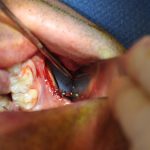
Augmentation of the jaw angle area is largely a male cosmetic facial procedure. Having a prominent jaw angle has long been recognized as an important element of the ‘strong jaw’ or masculine facial appearance. While perhaps not as important as having a well proportioned and horizontally sufficient chin, the jaw angle adds an important accent to the jaw line. Many prominent male celebrities and models can be seen with this look.
Like all facial augmentation, jaw angle implants are placed next to the bone area under the layer of tissue known as the periosteum. This involves splitting and lifting up a layer of muscle that overlies the bone. In the chin, for example, this is the mentalis muscle. But this muscle, like many other facial implant zones, is relatively small and does not affect any significant function. Jaw angle implants, however, are significantly different in this regard and that makes a big difference in the recovery process.
In placing jaw angle implants, the incisional access is done from inside the mouth back behind the molar teeth. The incision is made along the bone and the masseter muscle is lifted off of the front part of the ramus of the mandible all the way back to the angle and posterior ramus border. In lateral augmentation, the masseter muscle is lift just down to the lower edge of the bone. But in inferolateral augmentation, the lower edge of the muscle where it wraps around the bottom of the bone must be lifted off as well. Either way, the entire lower half of the large masseter muscle must be removed from the bone to accommodate the implant.

Jaw angle implants require about a month to return to normal jaw function and eating. When undergoing the procedure, one should be aware of this recovery issue as it is completely normal. Some may consider it a ‘benefit’ as not eating a normal diet for several weeks will usually result in some weight loss. At the least, it is a temporary inconvenience.
As the largest of the facial implants and given the amount of muscle that needs to be removed to accommodate its size, there will be a lot of lateral facial swelling. And it will take considerable time to go down as well. Therefore, I do not really judge the final results in terms of jaw angle size and symmetry for at least 6 weeks after surgery with three months being a more ideal final assessment time.
Dr. Barry Eppley
Indianapolis Indiana


